I’ll start by saying I’m interested in the Frontier format. The whole reason I made this site is because I think Frontier has the potential to be a fun and interesting way to play Magic: the Gathering, and also a good competitive format (which is the main way I play MTG). I haven’t actually built any decks or played Frontier, nor has anyone I personally know, but I am interested enough that I want to dig a little deeper into the fledgling format.
One thing that frustrates me is that among many recent posts there are a lot of commenters who seem quick to put the format down, without really looking into the reality of Frontier or trying it out for themselves. I wanted to write this article to critically examine some of the (often uninformed) concerns people have voiced about the format, and see whether or not the limited information we have about the format so far agrees with them.
To do this I looked at the top decklists from some recent Frontier tournaments (with >15 players). This included the following: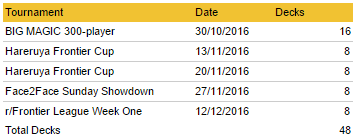
This group featured a total of 30 unique decks with 275 unique cards (not counting sideboards). The overall breakdown of archetypes was as follows: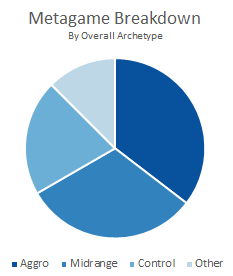
I have to admit I was quite excited to see this as I had heard a lot of people complain that the format would be one big “midrange grindfest”. I was glad to see aggro alive and well (and in fact the most popular archetype) as well as a healthy amount of control and combo.
From here I looked at some of the common criticisms I had seen on reddit over the past couple of weeks and attempted to dismiss or validate them using the data I gathered. This is by no means a comprehensive verdict on the format, the data is very limited and only time will tell what Frontier is really like. But hopefully this article might show some of the critics of Frontier that the format might have more to offer than they expect, and ultimately encourage some more players (myself included!) to try it out.
I will post links to the decklists at the end of the article, so please check out any of the decks that interest you. For now, let’s have a look at what concerns people about Frontier.
A Fetch too Far
“Fetchlands are unhealthy and should be banned from the format”
This seems to be a common complaint about Frontier. The issues people raise about fetchlands vary from “it’s too easy to play four colours” to “enjoy shuffling for ten minutes every game”. Let’s take a look at the most commonly played lands among our 48 decks to see if fetchlands really dominate like people claim they will.
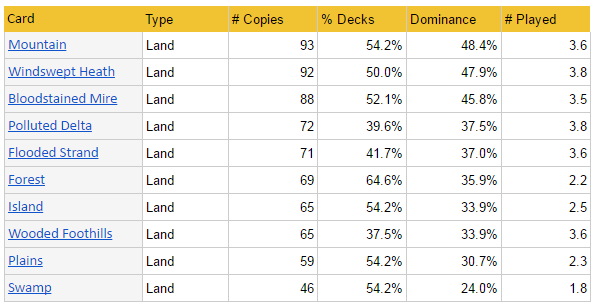
Welp…
For better or for worse, Frontier’s mana is defined by fetchlands. Across these 5 events, the average number of fetchlands per deck was just over 8, with the least popular ( Wooded Foothills) appearing in over one-third of decks! A mere 4 decks were running no fetchlands at all. Hardly surprising though when they are surely the best mana-fixing option in the format. The numbers certainly say fetchlands are a part of life at the Frontier, however the question of what is inherently wrong with a fetch-driven mana-base remains open to debate.
Personally, I like the interaction between allied fetches and allied Battle Lands. The bias towards four-colour decks in frontier is a product of this restriction combined with the powerful wedge-coloured gold cards and makes the format feel unique. I know a lot of people still have hurt feelings about this mana base from KTK-BFZ standard, but I would encourage players to give it a second chance.
I also enjoy that choosing which land to fetch can be a more impactful decision than just whether to shock yourself, which it so often boils down to in modern. Often in Frontier, players will have to choose between using their mana more efficiently (fetching a basic turn 1 or 2 to cast a spell) or better setting up their mana base by fetching a tapped land.
Excessive shuffling is something of a non-issue in my opinion. Searching and shuffling is a part of the game and impacts my enjoyment of Magic much less than not being able to cast my cards because of an inconsistent mana base.
The last complaint people have about fetchlands is that they are to expensive and will make the cost of playing of Frontier too high. I won’t really comment on this as I personally think price is a factor that has no impact on format health or enjoyability (although it is still important).
Whether fetchlands will ruin the gameplay of Frontier remains to be seen, however while they remain unbanned they will certainly be an integral part of the format.
The Ghosts of Standard Past
“Frontier will be ruled by the most dominant decks from recent standard formats”
Back in KTK-BFZ standard, when the best mana bases were similar to Frontier, the top decks were defined by a wedge and a splash colour; for example “Abzan Blue”, Mardu Green” and “Jeskai Black”. These may as well have been named “Rhino and Reflector Mage”, “Crackling Doom and Rhino” or “Mantis Rider and Crackling Doom”, as they were essentially a product of the mana making it easy to play powerful cards across the colour pie (in fact it was almost more difficult to play three colours!). This format drove many people away from standard and it’s unsurprising that they don’t want to revisit it.

The reality of this in Frontier is mixed. It’s true that some of the best decks in Frontier are just like those above; Mardu Green was the most popular deck with 5 copies among our 48 results. While it looks a little different courtesy of the wider card pool, it’s still basically the same excuse to play Crackling Doom on turn three and Siege Rhino on turn four. However unlike the doomsdayers believe, there are also plenty of three, two or even mono colour decks being played and winning.
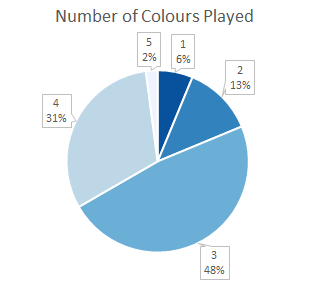
While one and two-colour decks are a little under-represented, it’s easy to see that three-colour decks are the runaway favourite. There was an average of 3.1 colours per deck. Of these, Grixis is the most popular combination, accounting for one-third of all three-colour decks. What this really shows is that while the often-dreaded four-colour goodstuff deck is a strong option in the Frontier environment, it’s far from the only option and at this stage I would certainly hesitate to call it (or any deck, for that matter) the best option.
It is certainly true that some of the best decks in Frontier are the strong decks from recent standard formats. When you think about the small pool of cards available in Frontier (it’s only two blocks bigger than standard) this is pretty understandable. Some of these decks appear very close to how they were in standard, for example Rally the Ancestors, which gets to play Satyr Wayfinder and Spell Queller but otherwise is mostly unchanged.
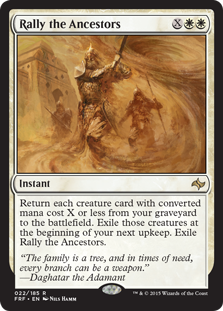
Other past standard stars have a number of new options that leave them less recognizable. For example with the addition of Elvish Mystic alongside cards like Grim Flayer, Smuggler’s Copter and Archangel Avacyn, Abzan players are no longer adding blue like they were in KTK-BFZ and instead building more streamlined, aggressive decks. The Bant Collected Company deck that dominated DTK-SOI standard is nowhere to be seen, with the namesake card appearing instead in Humans or Elves decks.
There are also a number of decks that saw a small amount of success during their run in standard that are doing much better in Frontier. The clear winners are Grixis Dragons and Grixis Control, with a combined five copies among the 48 decks. For Grixis, the combination of powerful draw spells from the Khans block like Dig Through Time, Jace from Origins and new powerful control cards like Liliana, the Last Hope, Unlicensed Disintegration and Torrential Gearhulk has pushed this archetype to the top tier.
Not to mention the many decks that never really had a chance in standard such as Goblins, Elves, Prowess, Jund, Bant Eldrazi or even decks like Bant Starfield. While some of these are likely fringe decks that can only find success due to the lack of a consistent metagame, Goblins, Elves and Prowess have all put up more than one top finish.
By the nature of the format many popular standard decks will appear in Frontier, however I think there is enough of a card pool to make things sufficiently different that the format feels new.
Big Fish in a Small Pond
“The card pool is so small that every deck will just play the same overpowered cards”
Note: for this section I excluded sideboards
This is a pretty logical conclusion to draw and if you look at the top performing cards it is somewhat true.
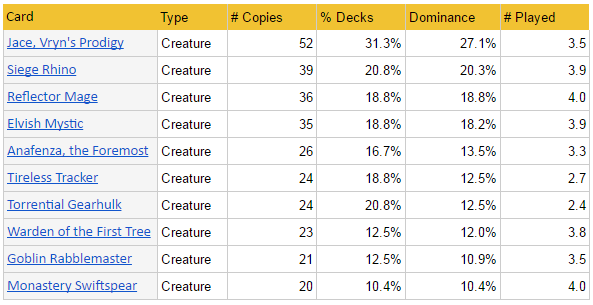
Dominance = # Copies / Total Decks * 4
As expected, Jace, Vryn’s Prodigy is the dominant creature. The extent to which Jace appears in Frontier decks is a little bit less than the top two spells in Modern, Lightning Bolt and Path to Exile. This makes sense; as Jace is a cheap and flexible planeswalker that fits in to a lot of decks (given the tendency toward 3 or 4 colour decks, over half of decks contain blue).
It is also worth noting that in standard the top 4 non-land cards range between 38-50% dominance, much higher than the most dominant cards in Frontier.
Once you go past Jace, the next most popular creatures – Siege Rhino, Reflector Mage and Elvish Mystic – are roughly as common as a Noble Hierarch or Gitaxian Probe in modern. This is actually less frequent than I expected, and at least for now seems like a healthy place for the format to be. We should expect the dominance of the top cards to be somewhere between modern and standard (due to the size of the card pool), and at the moment Frontier is much closer to the modern end of that spectrum.
Looking at spells, there is a similar distribution. Lightning Strike is king at 29% dominance (less than Lightning Bolt or Path to Exile in Modern), which seems reasonable as it is a cheap interactive spell. Dig Through Time coming in second might be a little more worrying, but so far it has been prominent but not oppressive. Interestingly, Collected Company, which many claim will dominate the format, appeared in less than 20% of decks (and around half of those were Rally the Ancestors).
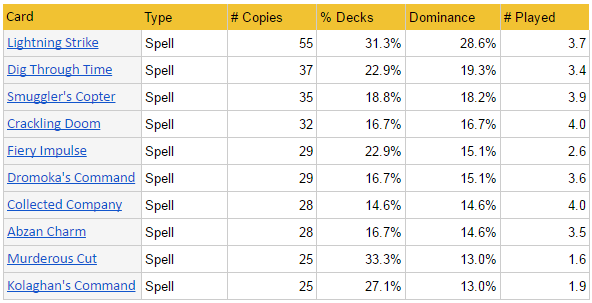
While there are several strong cards, they are less dominant than the best cards in standard and reasonably close to the popularity of modern staples, which logically feels like where the format should be at this stage. Only time will tell if the diversity is a function of Frontier being a new and unknown format, or if there really is a wide variety of strategies that can succeed in the format.
One Small Step for Magic Players
In the end, only time will tell whether Frontier is a fun, diverse and exciting format that Magic players will enjoy like they have Modern or Standard. But for now I have been pleasantly surprised by the data supporting that conclusion (to a degree).
I hope this article has inspired you to give Frontier a go (I certainly will!). Consider building or proxying some of the decks below to try out. I would be grateful if you could leave a comment with some feedback (as this is the first article I have written) and I will do my best to respond.
Thanks for reading!
The decks I looked at were:
- Jeskai Tempo
- 4c Control
- Bring to Light
- Rally the Ancestors
- Mardu Green
- Grixis Emerge
- Mardu Green
- Grixis Control
- Elves
- Atarka Red
- Abzan
- Abzan
- 4c Humans
- Abzan
- Jund
- Bant Humans
- Sultai Control
- Grixis Control
- 4c Control
- Jeskai Aggro
- Mardu Green
- Hardened Scales
- Prison Control
- Goblins
- Mardu Green
- Grixis Control
- Grixis Prowess
- 4c Aggro
- Goblins
- Bant Eldrazi
- Rally the Ancestors
- Mardu Green
- Abzan
- Rally the Ancestors
- Mono W Humans
- Elves
- Atarka Red
- Grixis Control
- Ensoul Artifact
- Rally the Ancestors
- Mardu Dragons
- Jund Aetherworks
- Bant Starfield
- Abzan
- Atarka Red
- Temur Flash
- Sultai Control
- Mardu Green



A very informative and good post(You did however confuse Elvish Visionary with Mystic at one point in the text.) This type of grounded in reality & positive attitude is exactly what Frontier needs, keep up the good work!
LikeLike
Hi Emil, thanks for pointing that out! (fixed). Appreciate the support.
LikeLike
Really interesting article. If i ever bring myself to invest in magic then it would be due to this format. It seems like a truly wide open format which is what i like to see. And if 4c decks run rampant then i would bet some crumble to dust + demolish + volcanic upheaval decks would start to show up pretty soon afterwards. Some of the decks that are not on the list and i wouéd be really interested in seeing if they are any good are Demonic Pact + Harmless offering (probably in grixis) and Esper Dragons. And Torrential Gearhulking a Dig Through Time sounds like exactly what i want to be doing in a game of Magic.
LikeLike
PS: I totally forgot Seasons Past as something to look at.
LikeLike
Thanks for the feedback Marton! I agree those all sound like interesting decks, and I’m sure it’s only a matter of time until they show up in the format.
(I think I figured out how to change that excerpt >_<)
LikeLike
Very good text and format analisis. Your study about Frontier is very acurate and serious. This kind of articles make magic reading so interesting and estimulating.
I think Frontier is a great new option to get fun and investigate new strategies to those people who are a bit tired of 2-turn games in modern or mirrors in std.
By the moment it seems so open and diverse format, and is obvious that near great decks will see much play, but it can’t be a problem ’cause is the same in any format. The clue is at this moment these decks are not so dominant in Frontier.
Congratulations for the job.
Oscar
LikeLike